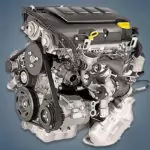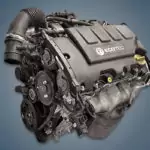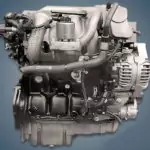The 1.6-liter turbo engine Opel A16LET or LLU was assembled from 2008 to 2013 in Hungary and installed on charged modifications of such popular models as Astra and Insignia. There are other versions in terms of power: A16LEL, A16LER and A16LES.
The A10 line includes: A12XER, A14XER, A14NET, A16XER, A16XHT and A18XER.
In 2008, as part of the third generation of GM Family 1 units, the LLU turbo engine made its debut, created for charged European models of the concern and known under the A16LET index. Structurally, there is a distributed injection, a cast-iron block with a closed cooling jacket, an aluminum 16-valve head not equipped with hydraulic lifters, a timing belt drive, a DCVCP-type phase control system on the intake and exhaust shafts, and a BorgWarner K03 turbine.
This engine is essentially the successor to the similar Z16LET turbo engine from Astra H and belongs to a whole line of supercharged power units, which also includes engines: A16LEL for 150 hp / 210 Nm, A16LER for 192 hp / 230 (266) Nm and A16LES at 209 hp / 250 (280) Nm.
The engine was installed on:
- Opel Astra J (P10) in 2009 – 2012;
- Opel Insignia A (G09) in 2008 – 2013.
Specifications
| Production years | 2008-2013 |
| Displacement, cc | 1598 |
| Fuel system | distributed injection |
| Power output, hp | 180 |
| Torque output, Nm | 230 |
| Cylinder block | cast iron R4 |
| Block head | aluminum 16v |
| Cylinder bore, mm | 79 |
| Piston stroke, mm | 81.5 |
| Compression ratio | 8.8 |
| Hydraulic lifters | no |
| Timing drive | belt |
| Phase regulator | DCVCP |
| Turbocharging | BorgWarner K03 |
| Recommended engine oil | 5W-30, 5W-40 |
| Engine oil capacity, liter | 4.5 |
| Fuel type | petrol |
| Euro standards | EURO 5 |
| Fuel consumption, L/100 km (for Opel Astra 2010) — city — highway — combined |
10.3 5.9 7.5 |
| Engine lifespan, km | ~200 000 |
| Weight, kg | 130 |
Disadvantages of the A16LET engine
- The most famous problem with this engine is the destruction of the piston of the 4th cylinder and the reason may be the quality of the pistons, detonation due to poor fuel and insufficient cooling of the rear of the cylinder block, however there is no exact answer.
- This engine has short-lived plastic pipes that constantly burst and unaccounted for air interferes with the operation of the flow meter and leads to unstable engine operation. Coolant pipes often crack and strong leaks appear.
- The BorgWarner K03 turbocharger is quite reliable and has a very long resource, but it is often let down by an electrovacuum wastegate control valve, as well as a constantly bursting membrane in the bypass valve itself.
- Other weak points of the motor include an unreliable ECU in which soldering is destroyed, an ever-cracking ignition module, a current heat exchanger, and a delicate crankcase ventilation membrane. Also here, the cylinder head gasket often breaks between the cylinders and a gas flow occurs.






